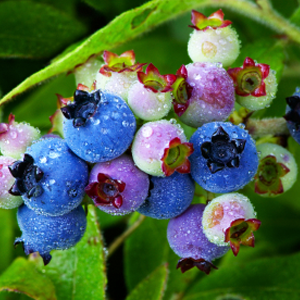El arándano se usa para prevenir cataratas y glaucoma y para tratar úlceras, infecciones del tracto urinario (ITU), esclerosis múltiple (EM), síndrome de fatiga crónica (SFC), cólicos, fiebre, venas varicosas y hemorroides. El arándano también se usa para mejorar la circulación y como laxante. Los nativos americanos usaban la potente fruta para tratar la tos.
El arándano se ubica entre las frutas más altas en antioxidantes (esas potencias que luchan contra los radicales libres). Deben sus distintivos azules y rojos profundos a su alto contenido de antocianinas. Las antocianinas de bayas han demostrado un amplio espectro de funciones biomédicas que incluyen trastornos cardiovasculares, estrés oxidativo inducido por la edad, respuestas inflamatorias y diversas enfermedades degenerativas. También pueden mejorar las funciones cerebrales neuronales y cognitivas, la salud ocular y proteger la integridad del ADN genómico.
Los flavonoides ejercen numerosas acciones neuroprotectoras dentro del cerebro, incluido el potencial de proteger las neuronas contra las lesiones inducidas por neurotoxinas, la capacidad de suprimir la neuroinflamación y el potencial de promover la memoria, el aprendizaje y la función cognitiva (2). Los fitonutrientes pueden poseer mecanismos de posible acción preventiva de enfermedades, incluidas propiedades antioxidantes, antibacterianas, antivirales y antiangiogénicas, producción mejorada de enzimas de desintoxicación, mejora de la salud inmunológica, reducción de la agregación plaquetaria, promoción de un perfil lipídico saludable, reducción de la hipertensión e impacto hormonal metabolismo. El arándano podría ayudar a prevenir las infecciones de la vejiga al evitar que las bacterias se adhieran a las paredes de la vejiga (1). La fruta de arándano tiene un alto contenido de fibra, lo que podría ayudar a la función digestiva normal. También contiene vitamina C y otros antioxidantes.
Se sabe que el estrés oxidativo, la activación microglial y los factores proinflamatorios disminuyen la proliferación celular y limitan la neuroplasticidad. Los polifenoles de los arándanos y el té verde son ricos en actividad antioxidante y antiinflamatoria que disminuye los efectos dañinos de las especies reactivas del oxígeno (ROS), en la sangre, el cerebro y otros tejidos del cuerpo (6). Se han presentado numerosas patentes que incluyen arándanos, extractos de té verde y vitamina D3 para aumentar la proliferación de células madre (3), (4). Un estudio que utilizó un compuesto similar indicó un aumento de células progenitoras en ratas envejecidas (5).
El arándano podría reducir los niveles de azúcar en sangre en personas con diabetes. Esté atento a los signos de niveles bajos de azúcar en la sangre (hipoglucemia) y controle cuidadosamente su nivel de azúcar en la sangre si tiene diabetes y usa productos de arándanos. Es posible que su proveedor de atención médica deba ajustar la dosis de sus medicamentos para la diabetes.
Stem Cells:
3)Davis Sanberg, Cyndy; Sanberg, Paul; Bickford, Paula; Shytle, R. Douglas; and Tan, Jun, "Combined effects of nutrients on proliferation of stem cells" (2008). USF Patents. Paper 612. http://scholarcommons.usf.edu/usf_patents/612
4)Kiss Z, inventor; Zoltan Laboratories Llc, assignee. Combinations of proteins to enhance viability of stem cells and their progenitors before transplantation. United States patent US 8,778,674. 2014 Jul 15. https://www.google.com/patents/US8778674
5)Bickford PC, Kaneko Y, Grimmig B, Pappas C, Small B, Sanberg CD, Sanberg PR, Tan J, Shytle RD. Nutraceutical intervention reverses the negative effects of blood from aged rats on stem cells. AGE. 2015 Oct 1;37(5):1-7. https://www.researchgate.net/profile/Yuji_Kaneko/publication/282248211_Nutraceutical_intervention_reverses_the_negative_effects_of_blood_from_aged_rats_on_stem_cells/links/560abc0108ae840a08d66954.pdf
6)Acosta S, Jernberg J, Sanberg CD, Sanberg PR, Small BJ, et al. (2010) NT-020, a natural therapeutic approach to optimize spatial memory performance and increase neural progenitor cell proliferation and decrease inflammation in the aged rat. Rejuvenation research 13: 581–588. https://www.ncbi.nlm.nih.gov/pubmed/20586644
Diabetes:
Grace, M. H., Ribnicky, D. M., Kuhn, P., Poulev, A., Logendra, S., Yousef, G. G., … Lila, M. A. (2009). Hypoglycemic activity of a novel Anthocyanin-rich formulation from Lowbush Blueberry, Vaccinium angustifolium Aiton. Phytomedicine : International Journal of Phytotherapy and Phytopharmacology, 16(5), 406–415. http://doi.org/10.1016/j.phymed.2009.02.018 https://www.ncbi.nlm.nih.gov/pmc/articles/PMC2718544/
Neural and Disease Prevention:
1)Zafra-Stone, S., Yasmin, T., Bagchi, M., Chatterjee, A., Vinson, J. A. and Bagchi, D. (2007), Berry anthocyanins as novel antioxidants in human health and disease prevention. Mol. Nutr. Food Res., 51: 675–683. doi:10.1002/mnfr.200700002 http://onlinelibrary.wiley.com/doi/10.1002/mnfr.200700002/abstract
2)Vauzour, D., Vafeiadou, K., Rodriguez-Mateos, A., Rendeiro, C., Spencer, J. P. E. “The neuroprotective potential of flavonoids: a multiplicity of effects", Genes & Nutrition,(2008), 3(3), 115—126. Doi=10.1007/s12263-008-0091-4. http://portal.unidoscontraelparkinson.com/Libreria/Tratamiento-Esp_Eng/The%20neuroprotective%20potential%20of%20flavonoids.207.pdf
Van Praag H. Exercise and the brain: Something to chew on. Trends in neurosciences. 2009;32(5):283-290. doi:10.1016/j.tins.2008.12.007. https://www.ncbi.nlm.nih.gov/pmc/articles/PMC2680508/
Murphy T, Dias GP, Thuret S. Effects of Diet on Brain Plasticity in Animal and Human Studies: Mind the Gap. Neural Plasticity. 2014;2014:563160. doi:10.1155/2014/563160. https://www.ncbi.nlm.nih.gov/pmc/articles/PMC4037119/
Duffy KB, Spangler EL, Devan BD, Guo Z, Bowker JL, Janas AM, Hagepanos A, Minor RK, DeCabo R, Mouton PR, Shukitt-Hale B, Joseph JA, Ingram DK. A blueberry-enriched diet provides cellular protection against oxidative stress and reduces a kainate-induced learning impairment in rats. Neurobiol Aging. 2008;29(11):1680-9. doi:10.1016/j.neurobiolaging.2007.04.002 http://www.neurobiologyofaging.org/article/S0197-4580(07)00163-7/fulltext
Prostate Cancer:
Understanding Prostate Cancer – Prevention http://www.webmd.com/prostate-cancer/guide/understanding-prostate-cancer-prevention
